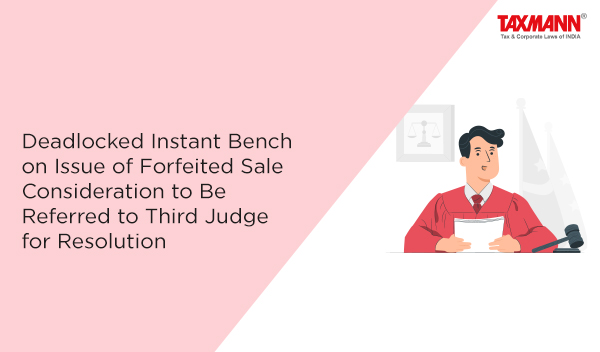Deadlocked Instant Bench on Issue of Forfeited Sale Consideration to Be Referred to Third Judge for Resolution
- Blog|News|Insolvency and Bankruptcy Code|
- 3 Min Read
- By Taxmann
- |
- Last Updated on 11 January, 2024

Case Details: Shri Karshni Alloys (P.) Ltd. v. Ramakrishnan Sadasivan Liquidator of Surana Industries Ltd. - [2024] 158 taxmann.com 237 (NCLAT-New Delhi)
Judiciary and Counsel Details
-
- M. Venugopal, Judicial Member & Shreesha Merla, Technical Member
- Virender Ganda, Sr. Adv. Vishal Ganda, Akanksha Mathur & Ms Tanya Hasija, Advs. for the Appellant.
- T.K. Bhaskar, Mayan H. Jain & Ms Niveditha Narayanan, Advs. for the Respondent.
Facts of the Case
In the instant case, the Appellant Shri Karshni Alloys (P.) Ltd. was an auction purchaser whose bid was accepted in an e-auction for the sale of corporate debtor (CD) as a going concern for Rs. 105.21 crores.
Thereafter, an application was filed by the liquidator seeking confirmation of the bid, for the ‘sale of assets’, of the corporate debtor. NCLT (AA) approved the said application with a direction to pay sale consideration, within 15, days from the date of receipt of the order. The said period had ended on 15.04.2022.
Subsequently, the appellant submitted a request for an extension of time before the NCLT, AA allowed the same. Further, AA also specified that any deviation’, from the same, would amount to ‘forfeiture’, of the ‘entire amount’ paid by the Applicant.
Appellant failed to pay the balance amount within the extended time also.So, the entire amount paid by the appellant was forfeited. The appellant again filed an application before AA, seeking an extension of time to make the balance payment and to quash and set aside the forfeit order.
AA rejected the said application on the ground that the appellant had consciously sought an extension of time for payment and no further relief of extension of time could be granted.
Thereafter the appellant filed an instant appeal on the ground that without any prayer for forfeiture, AA had overreached its power by directing same.
Consequently, as per Regulation 43 of Liquidation Regulations, 2016, only 10 % of the bid amount was to be forfeited and the balance amount which had been distributed amongst themselves was required to be refunded. The same has also been specified in clause 9 of the Bid offer, and the balance amount distributed by Stakeholders, during the pendency of the Appeal, was directed to be refunded.
According to the Judicial member, stakeholders had considered extension of payment till 30.05.2022. But the appellant had committed default once again and, later, applied for an extension of time by the appellant, which was listed on 29.06.2022. Till that date, the obligation of the appellant had remained as an unsettled one.
NCLAT Held
The NCLAT observed continuous extension prayed for the appellant was clearly pointed out that appellant’s inability to ‘infuse’ funds, for implementing sale proposal.
Also, the NCLAT observed that a sufficient time period of six months, for arriving at resources/source of funds for implementing proposals was provided however, the appellant had not made efforts for arranging a process over funds, for six months and only after receipt of AA order had woken up.
NCLAT concluded that there was a consistent and, persistent default on the appellant’s part, in not paying the amount and in short, the appellant had not adhered, to time schedule in terms of AA’s order.
Therefore, the impugned order passed by AA forfeiting the entire amount was free from all legal errors.
Further, on appeal, it was found that members of instant bench differed in their judgments and were equally divided on material issue of forfeited amount.
As per technical member, the appellant had made a payment of Rs.37.80 Crores, which was more than 30 percent of sale consideration and admittedly could not pay balance amount within specified period of time. The, only clause in bid offer, which referred to forfeiture, was 10 per cent of bid amount.
Therefore,the NCLAT also ordered that the registry was to be directed to immediately place record before the chairperson for constituting an appropriate Bench (Third Judge) for his opinion so that the judgment could be rendered in accordance with the opinion of the majority.
List of Cases Reviewed
-
- Shri Karshni Alloys (P.) Ltd. v. Liquidator of Surana Industries Ltd. [2024] 158 taxmann.com 236 (NCLT -Chennai) (para 154). Affirmed See Annex
Disclaimer: The content/information published on the website is only for general information of the user and shall not be construed as legal advice. While the Taxmann has exercised reasonable efforts to ensure the veracity of information/content published, Taxmann shall be under no liability in any manner whatsoever for incorrect information, if any.

Taxmann Publications has a dedicated in-house Research & Editorial Team. This team consists of a team of Chartered Accountants, Company Secretaries, and Lawyers. This team works under the guidance and supervision of editor-in-chief Mr Rakesh Bhargava.
The Research and Editorial Team is responsible for developing reliable and accurate content for the readers. The team follows the six-sigma approach to achieve the benchmark of zero error in its publications and research platforms. The team ensures that the following publication guidelines are thoroughly followed while developing the content:
- The statutory material is obtained only from the authorized and reliable sources
- All the latest developments in the judicial and legislative fields are covered
- Prepare the analytical write-ups on current, controversial, and important issues to help the readers to understand the concept and its implications
- Every content published by Taxmann is complete, accurate and lucid
- All evidence-based statements are supported with proper reference to Section, Circular No., Notification No. or citations
- The golden rules of grammar, style and consistency are thoroughly followed
- Font and size that’s easy to read and remain consistent across all imprint and digital publications are applied



 CA | CS | CMA
CA | CS | CMA
